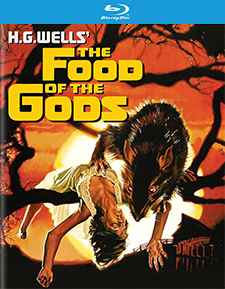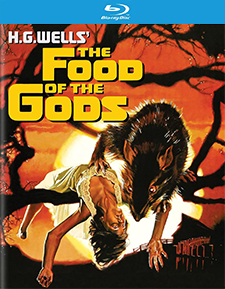Food of the Gods, The (Blu-ray Review)

Director
Bert I. GordonRelease Date(s)
1976 (August 27, 2024)Studio(s)
American International Pictures (Kino Cult #10)- Film/Program Grade: C+
- Video Grade: B+
- Audio Grade: A
- Extras Grade: B+
Review
H.G. Wells’ novels supply the basis for many fantasy and science fiction motion pictures, such as The Invisible Man, The War of the Worlds, The Time Machine, and The Island of Dr. Moreau. Wells’ plots lend themselves well to the visual medium of movies, which can bring his images to life through the magic of special effects. One of the author’s lesser known adaptations is 1976’s The Food of the Gods.
Football player Morgan (Marjoe Gortner, Bobbie Jo and the Outlaw), his teammate Davis (Chuck Courtney, The Gumball Rally), and the team’s press agent, Brian (John Cypher, Blade), take a hunting trip to a small Canadian island for a brief vacation before a big upcoming game. Aboard the ferry to the island, Morgan recalls the admonitions of his father, who spoke often about man’s disregard for the planet.
As they stalk game through the woods, Davis is attacked by huge wasps, leaving a swollen, bloody corpse. Seeking help, Morgan and Brian run to a farm and enter the barn in the hope of finding someone there. Instead, they encounter an enormous, aggressive rooster and several oversized chickens. The two men battle the murderous rooster, kill it, and find a frightened farmwife, Mrs. Skinner (Ida Lupino, High Sierra), in the adjoining house. They learn that Mrs. Skinner has been feeding the animals a special food made from a white substance bubbling out of the ground. But other creatures—worms, rats, and of course the wasps—have gotten into the feed and are now monstrous in size. The rats, in particular, are ravenous and seem to prefer people as their main dish.
Other characters show up. These include Jack Kensington (Ralph Meeker, The Anderson Tapes), a ruthless businessman intent on profiting from this amazing food; his female colleague, bacteriologist Lorna (Pamela Franklin, The Prime of Miss Jean Brodie); a young couple, Thomas (Tom Stovall, Silkwood) and his pregnant girlfriend Rita (Belinda Balaski, Piranha); and Mr. Skinner (John McLiam, Bite the Bullet), who gets a flat tire at absolutely the wrong moment.
Written, produced and directed by Bert I. Gordon, the movie’s largely uninspired actors and often unconvincing special effects, also credited to Gordon, do little to draw us into his bare-bones plot. Most of the effects involve the rats, which are filmed in close-up with miniature shrubbery surrounding them. These images are occasionally blended with the actors through split screen or matting to give a semi-realistic appearance, but seen alone, the rats never convince that they’re outsize rodents.
Originally released by American International Pictures, The Food of the Gods is a low-budget feature that harks back a couple of decades to when giant creatures ruled the screen. The 50s was the era that gave us The Black Scorpion, Them!, and The Deadly Mantis, among others. The 70s saw a resurgence of the monster creature subgenre. The screenplay is an excuse for a gore-fest and includes nearly every horror flick cliche, including an isolated area, a small group of cardboard characters whose number will gradually dwindle, a supposedly invincible enemy, and dumb decisions. That being said, the movie is entertaining with its cost-saving effects and the presence of Hollywood Golden Age star Ida Lupino.
Lupino plays the ultra-religious wife of the farmer, who’s away trying to make a deal for the special food that will make them rich. Looking confused, as if she wandered in from a Bogart drama of the 40s, Lupino adds her stature to a movie that doesn’t deserve it. Her role is fairly small and her character has little to do other than stare out of her cabin window, hold a shotgun on Morgan, and do unconvincing battle with a few giant worms. Clearly under-directed, she sadly coasts through the movie.
Gortner is a typical action horror star—brave, strong, a natural leader. As Morgan, he gets to ride a horse, blow up a giant wasp nest, fend off swarms of hungry rats, race around the island in his unprotected, open jeep, and even has time for an out-of-nowhere romantic scene with Franklin’s Lorna. Gortner did low-budget films and lots of TV in the 70s and 80s, so his name was familiar to audiences and good box-office.
Director/writer/producer Gordon was known for being in total control of this movies. You can see his hand in every frame of The Food of the Gods. He even took on the role of rat wrangler, teaching a bunch of rats to move in a particular direction or swarm over a miniature house and car. He even made it look like the rats were drowning after a dam was intentionally blown up to flood the area. His problem is including too much footage of the rats alone. The matte and split-screen shots aren’t bad, but he dilutes their impact by showing so much other, less believable footage.
The Food of the Gods was shot by director of photography Reginald H. Morris on 35 mm film with Panavision Panaflex cameras and Panavision spherical lenses, finished photochemically, and presented in the aspect ratio of 1.85:1. Kino Cult brings the film to Blu-ray for a second time using the same HD master that was included on Scream Factory’s 2015 Double Feature Blu-ray, which was paired with and shared the same disc as Frogs. Kino’s release gives the presentation more disc space to breathe at a much higher bitrate, though the quality varies. The mist-covered island adds atmosphere. The woods through which Morgan and his friends hunt features a vibrant green palette of trees and shrubbery as the sun shines through. Complexions are rendered well. A close-up of the swollen, bruised face of Davis features effective make-up. Blood in various scenes looks too bright. There’s little attempt to give the cabin interior a sense of foreboding. Special effects of the rats swarming over the cabin look good, but other scenes fail to convince. A few mattes improve the overall look of the effects, but they’re used sparingly, probably to save money. Dummy heads of the rooster and various rats are shown fleetingly to preserve the illusion that the characters are fighting giant animals.
The soundtrack is English 2.0 DTS-HD Master Audio with optional subtitles in English SDH. Dialogue is clear and distinct. When images of the giant rats are shown, a skittering, scampering sound is heard and later, when they’re chewing on the cabin, there are unsettling noises of their teeth gnawing at the wood. Other sound effects include the loud engine of Morgan’s jeep, the ferry gently pulling into the dock on the island, cars driving off the ferry, horses galloping, giant wasps buzzing, and glass shattering. Elliot Kaplan’s score amps up excitement a bit but it’s basically typical action flick music.
Bonus materials on the Region A Blu-ray release from Kino Cult include the following:
- Audio Commentary by Lee Gambin and John Harrison
- Audio Commentary by Bert I. Gordon
- Rita and the Rats with Actress Belinda Balaski (11:36)
- Radio Spots (1:58 – 4 in all)
- TV Spots (1:03 – 2 in all)
- Trailer (1:01)
- Empire of the Ants Trailer (2:19)
- Frogs Trailer (2:12)
- Squirm Trailer (1:56)
- Kingdom of the Spiders Trailer (1:53)
- Bobbie Jo and the Outlaw Trailer (1:53)
Audio Commentary #1 – Film critic and author Lee Gambin and John Harrison (author of WILDCAT: The Films of Marjoe Gortner) note that The Food of the Gods is based on the 1904 novel by H.G. Wells. The film’s credits indicate that the movie is based on “portions” of the novel. The Food of the Gods is an “environmental horror film,” made at a time when there was greater interest in preserving and protecting nature and wildlife. Marjoe Gortner plays a football hero, a change of pace from the typical roles he’d been playing. The movie was shot on a small island in British Columbia, Canada. The hunting sequence suggests man’s need to conquer the wilderness, but nature can push back when the natural order has been disturbed. Ida Lupino wasn’t paid a lot of money and wasn’t happy with the production, though with the passage of years, she came to look upon it more favorably. Lupino was one of the first female directors in Hollywood and went on to direct many episodes of TV shows.
Audio Commentary #2 – Writer/director/producer Bert I. Gordon is interviewed. Unfortunately, his answers don’t reveal too much. He tends to answer questions in only a few words and doesn’t elaborate. He has forgotten many details of the production, making this commentary less informative than one would hope. He knew most of the cast before they auditioned. He decided to make Morgan a football player to establish his athleticism and strength. No extras were used in the film. The people you see other than credited actors, such as the ferry operators, are real workers doing their jobs. The major location—the Skinner house—was rented. According to Gordon, “We took over the whole island.” He speaks about the film’s special effects and acknowledges that Ida Lupino “holds the whole movie together.” Lupino was on location for four weeks and gives an authentic performance with no trace of campiness. The rats were shot at high speed to make their movements slow down on screen. This suggests that they’re bigger and heavier than a typical rat. The rats weren’t always cooperative, even though cheese was the usual inducement. When asked about the reaction to the movie, Gordon says audiences loved it. He attended sneak previews and was happy to see and hear the audience laughing or screaming in the right places.
Rita and the Rats – As the pregnant Rita, actress Belinda Balaski had to learn about what it was like to give birth, so she attended a Lamaze class. She got the part after meeting Marjoe Gortner. He and Balaski got along well. There was a lot of unexpected snow, which had to be burned off for exterior filming. During time off, Ralph Meeker would play piano and Ida Lupino, seated atop the piano, would sing. Balaski says of being on location, “Some of the best moments were off-screen.” The crew was supposed to be on location for ten days but the shoot lasted six weeks. About the special effects, she notes that imagination is essential to summon great fear even though the technical aspects of filmmaking are visible. She acknowledges that Bert I. Gordon was practically a one-man crew. “They don’t call him Mr. BIG for nothing.”
This release also features reversible artwork and a slipcover. The 2015 Scream Factory Double Feature Blu-ray included a photo gallery, which hasn’t been carried over.
The Food of the Gods isn’t a good movie, but it sure is entertaining. This is a textbook example of how a limited budget can stretch. With a few name actors, a few workable effects, and some astute editing, the sparsely scripted, cliche-ridden, often predictable film is still enjoyable. Watching The Food of the Gods will remind viewers of the uncomplicated fun they had as kids during Saturday matinees at their local movie theater.
- Dennis Seuling

